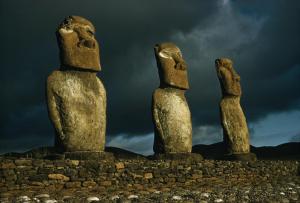- Welcome
- About Life
- National Geographic and Life
- Teacher Resources
- Customizing Life to your course hours
- Interactive Whiteboard Video Tutorial
- Student's Book and Workbook Audio
- CEFR correlations
- Audioscripts (Word)
- Reading Texts (Word)
- Videoscripts (Word)
- Business Writing Worksheets
- Communicative Worksheets
- Extra Practice Activities
- Life Grammar Practice Worksheets
- Multilingual and monolingual word lists
- Ready-made Lessons
- Split editions teacher's book references
- Student's Book Answer Keys
- Web research for Life
- Video
- Test Centre
- Student Zone
If Statues Could Talk

How did the Easter Island statues move? Archaeologists are still trying to work out how - and what their story really means.
On a winter night last June, José Antonio Tuki, a 30-year-old artist on Easter Island, sat on Anakena beach and stared at the enormous human statues there – the moai. The statues are from four feet tall to 33 feet tall. Some weigh more than 80 tons. They were carved, a long time ago, with stone tools and then they were moved up to 11 miles to the beach. Tuki stares at their faces and he feels a connection. ‘This is something that was produced by my ancestors,’ he says. ‘How did they do it?’
The first Polynesians arrived at Rapa Nui (Easter Island), probably by canoe, hundreds of years ago. The island is 2,150 miles west of South America and 1,300 miles east of its nearest inhabited neighbour, Pitcairn. Nowadays 12 flights arrive every week from Chile, Peru and Tahiti. In 2011, 50,000 tourists – ten times the island’s population – flew to Easter Island. Almost all of the jobs on Easter Island depend on tourism. And the tourists go there for only one thing: the moai.
People around the world became curious about the statues after the Norwegian adventurer Thor Heyerdahl made Easter Island famous, and there are different theories about how the statues were moved to the beach. Many researchers think the statues were pulled along the ground using ropes and wood.
Pulitzer Prize winner Jared Diamond has suggested that many people were needed to build and move the moai. As a result, the island’s trees were cut down for wood and to create farming land. This open land was fragile and it was soon eroded by the strong winds, so it was very difficult to grow food. The situation was an early example of an ecological disaster, according to Diamond.
On the other hand, archaeologists Terry Hunt of the University of Hawaii and Carl Lipo of California State University Long Beach have a more positive view of the island’s history. They suggest that the inhabitants actually pioneered a type of sustainable farming – they built thousands of circular stone walls, called manavai, and grew food inside them. And their theory about how the moai were moved is that they were ‘walked’ along using a system of only ropes and a few people.
As José Tuki contemplates these enormous statues, he doesn’t mind that there are no definite answers about the history of his island. ‘I want to know the truth,’ he says, ‘but maybe knowing everything would take its power away.’
Keywords:
carve
(v) to make an object by cutting it out of a substance such as wood or stone
curious
(adj) interested in something and wanting to know more about it
erode
(v) if the weather, sea or wind erodes rock or soil, it cracks and breaks it so that it is damaged
fragile
(adj) easily broken or damaged
inhabitant
(n) the inhabitants of a place or region are the people who live there
land
(n) an area of ground, rather than the sea or the air
power
(n) the ability of something to have a strong effect on things or people
stare
(v) to look at someone or something for a long time
tool
(n) a simple piece of equipment that you hold in your hand and use to do a particular kind of work
weigh
(v) if you weigh a particular amount, that is how heavy you are
Reading comprehension:
Read the article and choose the correct option.
are new constructions to attract tourists.
aren’t completely understood by archaeologists.
were destroyed by the islanders.
2 On Easter Island today, the statues ...
are very important for tourism.
are not important for tourism.
are a problem for tourism.
3 The people of Easter Island today ...
don’t have a lot of contact with the rest of the world.
can’t find jobs on the island.
work in the tourism industry.
4 Studying the moai ...
can tell us about the people who lived on the island.
is important to the farmers on Easter Island.
helps us to understand the art of José Tuki.
Read the article again and choose the correct option.
is from Easter Island.
came to Easter Island to work.
carves statues on Easter Island.
6 The moai ...
are statues of animals.
are all the same size.
were made by José Tuki’s ancestors.
7 Easter Island ...
is part of the South American continent.
is a long way from other inhabited places.
is an uninhabited island.
8 People travel to Easter Island ...
by boat.
to work.
to see the statues.
9 Jared Diamond thinks that ...
farmers on Easter Island planted a lot of trees.
there were environmental problems on Easter Island.
the population of Easter Island was always small.
10 Hunt and Lipo think people moved the statues using ...
wood.
ropes.
both wood and ropes.